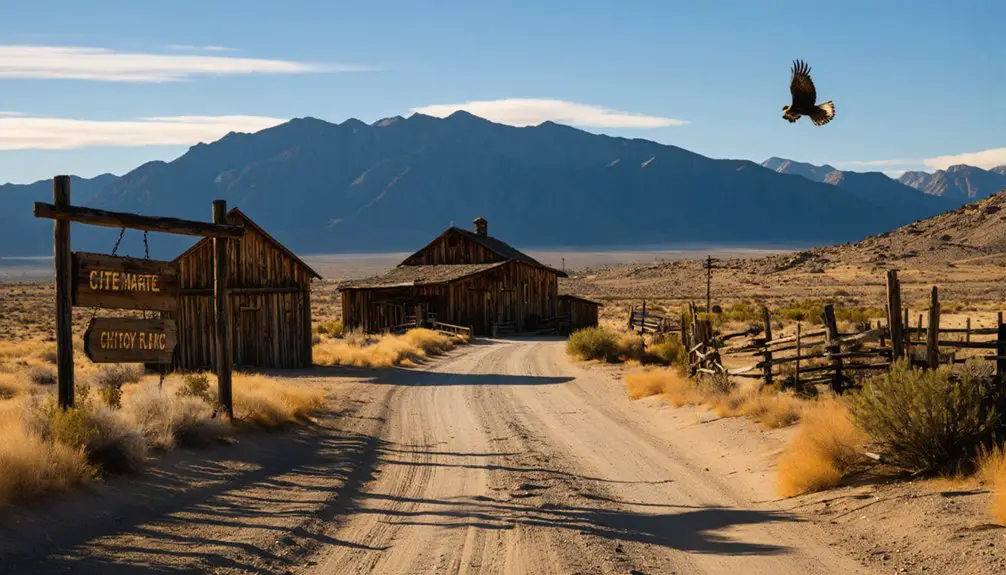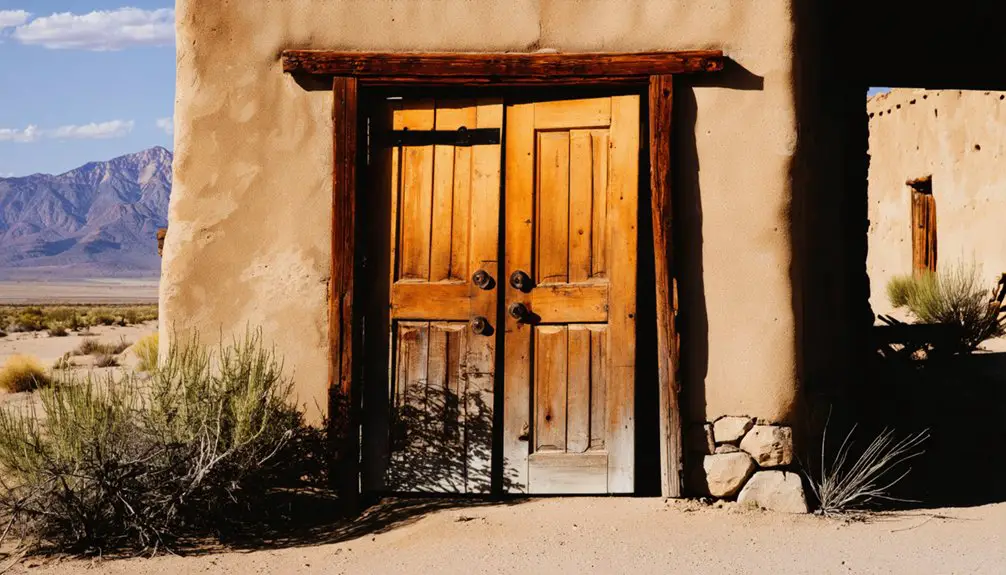You’ll find St. Thomas ghost town beneath Lake Mead’s waters, periodically emerging during drought conditions. Originally settled by Mormon pioneers in 1865, this frontier town thrived until 1938 when rising reservoir waters forced residents to abandon their homes. Today, you can explore concrete foundations, building ruins, and agricultural remnants via a 3-mile dirt road within Lake Mead National Recreation Area. The site’s dramatic story of submersion and reemergence reveals complex tensions between progress and preservation.
Key Takeaways
- St. Thomas was a Mormon settlement established in 1865 that became submerged beneath Lake Mead’s waters in 1938.
- The ghost town periodically resurfaces when Lake Mead’s water levels drop, exposing building foundations and historical ruins.
- Visitors can access the site via a 3-mile dirt road within Lake Mead National Recreation Area.
- Archaeological discoveries include Native American artifacts dating back to 900 AD and remnants of pioneer life.
- The site features remains of a school, church, grocery stores, and a mechanic’s garage from the original settlement.
The Mormon Settlement Years (1865-1938)
Three distinct phases marked the Mormon settlement of St. Thomas. The initial phase began in 1865 when Brigham Young sent missionaries to establish a cotton-growing community.
You’ll find that by 1866, 45 families had created a thriving settlement with sophisticated irrigation systems drawing from the Muddy River. The area became a crucial intersection for native Paiute tribes who interacted regularly with the Mormon settlers. By 1869, the community enhanced farming capabilities with concrete-lined canals to support diverse crop production.
The second phase emerged in 1870 when boundary changes placed St. Thomas in Nevada, forcing most of the Mormon community to abandon the town rather than pay back taxes.
Yet the third phase showed resilience, as new settlers, including some remaining Mormons, rebuilt the town into a diverse frontier settlement with schools, hotels, and railroad connections.
This Mormon influence continued until 1938, when the rising waters of Lake Mead, created by Hoover Dam, finally submerged the town completely.
Lake Mead’s Rising Waters
While St. Thomas’ remains now rest beneath Lake Mead‘s waters, you’ll find the site’s visibility varies dramatically with water level fluctuations. Recent data shows the lake at 1,055.62 feet as of September 2025, about 173 feet below capacity, affecting ghost town preservation efforts near the shoreline. The reservoir’s critical state threatens millions of water users across three southwestern states. Glen Canyon Dam releases about 8.23 million acre-feet annually to regulate water flow downstream.
- Historical structures emerge when water levels drop below 1,045 feet
- Marina relocations and closures have transformed lake access points
- Drought conditions continue to expose previously submerged ruins
You’re witnessing a dynamic interaction between human history and natural forces, as Lake Mead’s changing elevations alternately conceal and reveal this once-thriving settlement.
The lake’s recent record low of 1,040.58 feet in July 2022 briefly exposed more of the town’s foundations than seen in decades, though subsequent slight rebounds have submerged portions once again.
Life Before the Flood
Before Lake Mead’s waters claimed St. Thomas, you’d have found a thriving frontier settlement where Mormon pioneers cultivated the fertile soil near the Virgin and Muddy Rivers.
The town’s 14-room hotel hosted notable figures, including President Calvin Coolidge, while the general store and schoolhouse served as hubs for community events and education.
Agricultural practices centered on self-sufficiency, with residents working the land to sustain their remote desert community.
You’d have witnessed a tight-knit society bound by shared religious values, where church activities shaped daily life.
Despite facing economic challenges and jurisdictional disputes with Nevada authorities, the townspeople maintained their cultural traditions until 1938.
Brigham Young’s request led to the establishment of this Mormon settlement in 1865, marking the beginning of St. Thomas’s pioneering legacy.
When Hugh Lord torched his home before departing, it marked the end of a remarkable chapter in Nevada’s frontier history.
The rising waters of Lake Mead eventually submerged the town under seventy feet of water.
Archaeological Discoveries and Preservation
You’ll find a wealth of history in St. Thomas’s pre-flood archaeological discoveries, including tools, weapons, and everyday items recovered during the 1920s and 1930s excavations led by Mark Raymond Harrington.
The site’s ancient Native American heritage dates back to at least 900 AD, with evidence of agricultural settlements and salt mining operations by Pueblo Indians between 500-1200 AD. Early inhabitants constructed underground pit dwellings that provided natural insulation against extreme temperatures. Early settlers developed irrigation systems from the Muddy River to sustain their diverse crops.
Today’s preservation efforts focus on protecting both the re-emerged ruins within Lake Mead National Recreation Area and housing recovered artifacts in the Lost City Museum for future generations to study.
Pre-Flood Artifact Recovery
As archaeologists raced against rising waters in the 1920s and 1930s, extensive excavations at Thomas and the nearby Pueblo Grande de Nevada site revealed a rich tapestry of ancient human habitation dating back to 8,000 BC.
Led by Mark Raymond Harrington, teams worked diligently to recover artifacts of significant cultural value before Lake Mead’s waters claimed the area. The site was permanently submerged under seventy feet of water until 2002. The town’s official end came when the post office closed on June 11, 1938.
- Recovered items included woven baskets, stone tools, and weaponry that revealed complex trade networks and survival strategies.
- Excavation teams faced intense pressure due to impending flooding, forcing rapid documentation and recovery efforts.
- The artifact significance extended beyond physical objects, providing insights into early farming practices and social organization.
The recovered artifacts now reside in the Lost City Museum, preserving the region’s heritage despite the challenges posed by the rushed recovery operation and harsh desert conditions.
Native American Site Findings
Archaeological evidence reveals a rich Native American presence spanning thousands of years around St. Thomas.
You’ll find traces of Native agriculture dating back to 900 AD, with skilled farmers cultivating corn, beans, squash, and cotton along the Muddy River Valley. The Basketmaker culture established their presence around 300 AD, constructing innovative pit-houses with climate-controlled features.
The region’s archaeological record shows continuous human activity stretching back to 8000 BCE near Lost City.
Before Lake Mead submerged these precious sites, archaeologists and the Civilian Conservation Corps recovered countless artifacts in the 1930s, including intricate baskets, pottery, and agricultural tools.
Today, you can explore this heritage at the Lost City Museum, where recovered relics showcase the sophisticated land management and irrigation practices of these ancient peoples.
Preservation Techniques Today
The preservation of St. Thomas requires cutting-edge conservation methods to protect its historical significance. Modern technologies, including remote sensing and digital reconstruction, allow you to explore the town’s layout without disturbing the fragile ruins.
Advanced preservation techniques help combat erosion and environmental damage to the foundations that were long submerged underwater.
- Non-invasive archaeological surveys map exposed foundations during drought periods
- Digital documentation through photogrammetry and drone mapping creates precise site records
- Environmental monitoring systems track deterioration factors to guide preservation strategies
You’ll find designated hiking trails and interpretive programs that let you experience the site while protecting its integrity.
The National Park Service manages public access through educational signage and guided tours, ensuring you can connect with history while supporting ongoing preservation efforts.
When Waters Recede: Modern Ghost Town
Since Lake Mead’s water levels have drastically declined due to severe drought conditions, St. Thomas has re-emerged from its watery grave, revealing a ghost town that tells a complex story of water management and western settlement.
Once submerged beneath Lake Mead’s waters, St. Thomas now stands exposed, a haunting testament to America’s water management challenges.
You’ll find concrete foundations, building ruins, and agricultural remnants that have surfaced at least nine times as the reservoir’s levels fluctuate.
Walking through the exposed site, you can explore the town’s grid layout, including remains of a school, church, grocery stores, and mechanic’s garage.
The confluence of the Virgin and Muddy Rivers, once hidden beneath 80 feet of water, now shows why early settlers chose this location.
The site’s repeated emergence offers you a unique window into early Mormon settlement life, where Hugh Lord’s defiant final act of burning his house symbolizes the town’s reluctant surrender to progress.
Getting There: Visitor Access and Tips

You’ll find Thomas ghost town by traveling along a 3-mile dirt access road within Lake Mead National Recreation Area near the Overton Arm, though you should check your vehicle’s clearance before attempting the sometimes bumpy route.
Once parked, you can explore the site via two main trails – a double track used by park vehicles or a singletrack path through tamarisk vegetation – both approximately one mile in length.
The mostly flat terrain features dirt and gravel surfaces that are generally manageable for most visitors, but you’ll want sturdy shoes and plenty of water since the trails offer minimal shade.
Best Routes to Take
Located within Lake Mead National Recreation Area, St. Thomas is accessible via US-93 North from Las Vegas.
Take NV-169 east toward Overton, following signs to Lake Mead. For scenic routes, consider traveling through Valley of Fire State Park to connect with NV-169. The final stretch includes a 3-mile dirt road leading to the parking area at coordinates 36.465, -114.506.
Travel recommendations for accessing St. Thomas:
- Take US-93 North from Las Vegas to NV-169, then follow park signage to St. Thomas access road near Overton Bay Marina
- Drive cautiously on the unpaved access road – standard vehicles can manage, but low-clearance cars should proceed with care
- Check National Park Service alerts for current road conditions, especially after rain events
The parking area marks your starting point for exploring the ghost town ruins on foot.
Vehicle Preparation Required
While standard vehicles can access St. Thomas Ghost Town during dry conditions, you’ll need proper preparation to guarantee vehicle safety along the challenging 3.3-mile dirt road.
Equip your vehicle with a spare tire and repair kit to handle the sharp rocks and rough terrain. Maintain appropriate tire pressure to navigate both rocky and sandy sections effectively.
For terrain challenges, bring recovery gear including tow straps and a shovel in case you encounter soft patches. Since cell service is limited, pack extra water and supplies, and consider traveling with another vehicle.
You’ll need to drive slowly, often at 5 mph, to protect your vehicle from damage. A high-clearance 4×4 vehicle offers the safest option, especially if conditions are wet or muddy.
Trail Conditions & Accessibility
Once your vehicle reaches the parking area, a straightforward 0.6 to 1-mile trail leads to the St. Thomas ghost town site. The mostly flat terrain presents minimal elevation gain of about 85 feet, making it accessible for most hikers.
However, you’ll need to navigate unmaintained dirt paths and gravel sections that aren’t officially designed for mobility devices.
- Trail safety requires sturdy footwear due to occasional bumpy stretches and uneven surfaces
- Terrain challenges include encroaching tamarisk vegetation on singletrack sections
- No shade or water sources exist along the trail – bring adequate supplies
While park staff periodically clear vegetation, you’ll want to stay on designated paths to protect historical sites and guarantee your safety.
The trail’s moderate difficulty level allows for relatively easy exploration of this fascinating desert ghost town.
Historical Legacy and Cultural Impact

As the waters of Lake Mead periodically recede, St. Thomas emerges as a powerful symbol of both cultural significance and environmental impact in Nevada’s history.
The town’s submersion beneath Lake Mead in the 1930s represents a turning point where infrastructure development directly displaced an established community.
You’ll find that the town’s legacy lives on through descendant families like the Bonellis, who maintain connections to their pioneer roots.
During low water periods, former residents and their families have gathered at the site, creating a continuing bond with their submerged heritage.
The ghost town’s remains serve as a stark reminder of how water management policies can reshape communities.
St. Thomas’s story resonates particularly with those who value independence, as it demonstrates how government projects can fundamentally alter established ways of life.
Frequently Asked Questions
Are There Any Dangerous Animals or Snakes Near the Ruins?
Yes, you’ll need to watch for Mojave rattlesnakes and coyotes near the ruins. Practice wildlife safety by staying alert, wearing boots, and learning basic snake identification to protect yourself.
Can Visitors Take Artifacts Found at St. Thomas Home?
No, you can’t take artifacts home – it’s illegal and harms artifact preservation. Each item has historical significance that helps tell St. Thomas’s story when left in its original location.
Is Camping Allowed at or Near the Ghost Town Site?
Though you can’t camp right at the ghost town, camping regulations allow you to set up at nearby campsites like Boulder Beach, Katherine Landing, or Willow Beach within Lake Mead National Recreation Area.
What Happened to the Bodies in the Town Cemetery?
You’ll find that in 1935, officials relocated 48 graves from St. Thomas’s cemetery to Overton, Nevada, preserving the burial practices and cemetery history before Lake Mead’s waters could submerge the original burial ground.
Are There Any Underwater Diving Tours to See Submerged Structures?
You won’t find official underwater diving tours of St. Thomas currently, as low water levels have exposed most structures. Past diving experiences were possible, but today’s underwater exploration focuses on general Lake Mead recreation.
References
- https://travelnevada.com/ghost-town/st-thomas-ghost-town/
- https://www.nps.gov/lake/learn/nature/st-thomas-nevada.htm
- https://nevadamagazine.com/issue/september-october-2019/11227/
- https://nvtami.com/2022/03/27/st-thomas-ghost-town/
- https://ensignpeakfoundation.org/st-thomas-nevada/
- https://orc.library.atu.edu/atu_faculty_books/63/
- https://timetraveltrek.com/ghostly-remains-st-thomas-nevada/
- https://parks.nv.gov/learn/park-histories/old-las-vegas-mormon-fort-history
- https://en.wikipedia.org/wiki/St._Thomas
- https://www.statista.com/statistics/1225682/monthly-water-elevation-of-lake-mead-united-states/



